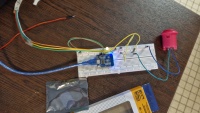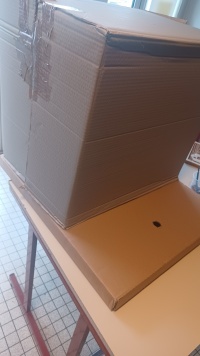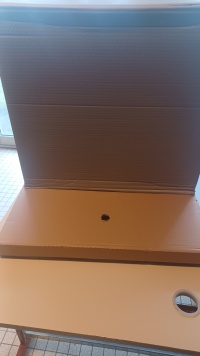ENIB 2024 : CatchTheJackpot : Différence entre versions
(→ne pas modifier sous cette ligne) |
(→Code :) |
||
| Ligne 41 : | Ligne 41 : | ||
==Code :== | ==Code :== | ||
| + | |||
| + | <syntaxhighlight lang="Arduino" line> | ||
//Programme fait sur carte STM8266 / WEMOS D1 mini | //Programme fait sur carte STM8266 / WEMOS D1 mini | ||
| Ligne 380 : | Ligne 382 : | ||
} | } | ||
} | } | ||
| + | </syntaxhighlight> | ||
==étapes de fabrication== | ==étapes de fabrication== | ||
Version actuelle datée du 6 mars 2024 à 16:13
Sommaire
description
Ce projet fonction grâce à une carte Arduino, des LEDs et un bouton.
Une lumière traverse le ruban de gauche à droite et lorsqu'elle est au milieu, il faut appuyer sur le bouton au bon moment pour gagner.
réalisé par :
-Arnaud Genty -Maxime Bintein -Tristan Le Coz
Introduction
éventuelle vidéo
Liste des composants
- Bouton poussoir style Arcade
- Arduino nano
- 2 rubans de LED adressable (85 LEDs pour être exacte)
- Carton
- Bois
- Câbles mini-USB
- Câbles
- écran LCD
- Breadboard
- 2 résistances de 500kΩ
- Buzzer
Outils
- Cutter
- Marqueur noir
- Pistolet à colle
- Scotch
- Fer à souder
- Scie à bois
- Perceuse
- Bibliothèque Arduino FastLed
https://fastled.io/
Code :
1
2
3 //Programme fait sur carte STM8266 / WEMOS D1 mini
4 #include "pitches.h"
5 #include "FastLED.h" //bibliothèque pour controler le ruban led
6 #include <Wire.h> //bibliothèque écran
7 #include <LiquidCrystal_I2C.h> //bibliothèque écran
8 #define REST 0
9 #define NUM_LEDS 86
10 #define NUM_OF_LEDS_BY_LEVEL 17 // nombre de leds par niveau
11 #define NUM_OF_LEVELS 5 // nombre de niveaux
12 #define PIN_BTN D3 // Entree du bouton
13 #define PIN_LEDS D4 // Sortie du ruban led
14 #define PIN_BUZZER D8 // Signal de sortie buzzer
15
16
17 // -------- INIT VARIABLES --------
18 LiquidCrystal_I2C lcd(0x27, 16, 2);
19 CRGB leds[NUM_LEDS]; //Création d'une liste avec chaque led
20 CRGB randomcolor = CHSV(random(192), 255, 255);
21 int level = 0; // niveau auquel le joueur est
22 int delay_level = 30; // délai qui permet de controler la vitesse de déplacement de la led
23 auto color = CRGB::Blue; // couleur de la led qui se déplace
24 int score = 0; // score du joueur
25 const double coef[] = {1,1.5,2,2.5,3}; // coefficient multiplicateur de point par niveau
26 int last_point[NUM_OF_LEVELS]; // sauvegarde de la derniere led allumée pour la rallumer après flash()
27 bool game_in_progress = false;
28 int last_point_visu = 0;
29
30
31
32 // -------- INIT FONCTIONS --------
33
34 int move(); // déplacement de la led
35 void level_up(); // passage de niveau
36 void waiting_start_game(); //affichage d'attente de début du jeu
37 void flash(); // animation de victoire d'un niveau
38
39 // -------- PROGRAMME --------
40 void setup() {
41 FastLED.addLeds<NEOPIXEL, D4>(leds, NUM_LEDS); // setup du ruban de led sur la sortie PIN_LEDS => 2
42 pinMode(PIN_BTN, INPUT); // setup du bouton dur l'entrée PIN_BTN => 3
43 FastLED.setBrightness(50); // setup de la luminosité
44 Serial.begin(9600); // setup moniteur série pour debug
45 int last_point[NUM_OF_LEVELS];
46 pinMode(PIN_BUZZER, OUTPUT);
47
48 // -------- ECRAN --------
49 lcd.init(); // Initialize I2C LCD module
50 lcd.backlight(); // Turn backlight ON
51 }
52
53
54 void loop() {
55 waiting_start_game();
56 lcd.setCursor(0,0);
57 lcd.print(" Cliquer ");
58 lcd.setCursor(0,1);
59 lcd.print(" pour commencer");
60 FastLED.clear();
61 if (digitalRead(PIN_BTN)==LOW){
62 musique();
63 game_in_progress = true;
64 lcd.clear();
65 lcd.setCursor(0,0);
66 lcd.print("Partie en cours !");
67 lcd.setCursor(0,1);
68 lcd.print("XoXoXoXoXoXoXoXo");
69 FastLED.clear();
70 delay(400);
71 while(game_in_progress){
72 move();
73 if (digitalRead(PIN_BTN)==LOW && game_in_progress==true){
74 level_up();
75 }
76 }
77 }
78 }
79
80
81 int move(){
82 // Permet de faire bouger la LED de gauche à droite
83 for (int i = NUM_OF_LEDS_BY_LEVEL * level; i <= (NUM_OF_LEDS_BY_LEVEL * level + NUM_OF_LEDS_BY_LEVEL - 1); i++){
84 // -------- DEBUGGING -------- //
85 /*
86 Serial.print("val de la led: ");
87 Serial.print(i);
88 Serial.print("\n");
89 */
90 if (digitalRead(PIN_BTN)==LOW){ //Stock des scores LEDs 1 -> 9 -> 1
91 int center = abs(i - (NUM_OF_LEDS_BY_LEVEL * level + NUM_OF_LEDS_BY_LEVEL / 2));
92 if (center <= NUM_OF_LEDS_BY_LEVEL/2) {
93 last_point[level] = NUM_OF_LEDS_BY_LEVEL/2 - center + 1; // Les points augmentent jusqu'à 9
94 } else {
95 last_point[level] = 0; // À partir de la position 9, les points diminuent
96 }
97 // if(i<(1/2*NUM_OF_LEDS_BY_LEVEL)){
98 // last_point[level] = i;
99 // }
100 // else{
101 // for(int degr = 1; degr<NUM_OF_LEDS_BY_LEVEL; degr++)
102 // last_point[level] = (i - degr);
103
104 // }
105 int last_point_visu = i-1;
106 return i-1;
107 // -------- DEBUGGING -------- //
108 /*
109 Serial.print("last_point_visu");
110 Serial.print(last_point_visu);
111
112 for(int z=0; z<NUM_OF_LEVELS; z++){
113 Serial.print(last_point[z]);
114 Serial.print("\n");
115 }
116 */
117
118
119 }
120 //Eteins les LEDs derrière la LED mouvante
121 leds[i - 1] = CRGB::Black;
122 delay(3);
123 leds[level * NUM_OF_LEDS_BY_LEVEL + NUM_OF_LEDS_BY_LEVEL / 2] = CRGB::Yellow;
124 leds[i] = color;
125 FastLED.show();
126 delay(delay_level);
127 }
128 leds[NUM_OF_LEDS_BY_LEVEL * level + 20] = CRGB::Black;
129 FastLED.show();
130 delay(delay_level);
131 for (int i = NUM_OF_LEDS_BY_LEVEL * level + NUM_OF_LEDS_BY_LEVEL - 1; i >= NUM_OF_LEDS_BY_LEVEL * level ; i--)
132 {
133 // -------- DEBUGGING -------- //
134 /*
135 Serial.print("val de la led: ");
136 Serial.print(i);
137 Serial.print("\n");
138 */
139 if (digitalRead(PIN_BTN)==LOW){ //Stock des scores LEDs 1 -> 9 -> 1
140 int center = abs(i - (NUM_OF_LEDS_BY_LEVEL * level + NUM_OF_LEDS_BY_LEVEL / 2));
141 if (center <= NUM_OF_LEDS_BY_LEVEL/2) {
142 last_point[level] = NUM_OF_LEDS_BY_LEVEL/2 - center + 1; // Les points augmentent jusqu'à 9
143 } else {
144 last_point[level] = 0; // À partir de la position 9, les points diminuent
145 }
146 // if(i<(1/2*NUM_OF_LEDS_BY_LEVEL)){
147 // last_point[level] = i;
148 // }
149 // else{
150 // for(int degr = 1; degr<NUM_OF_LEDS_BY_LEVEL; degr++)
151 // last_point[level] = (i - degr);
152 // }
153
154 int last_point_visu = i+1;
155 return i+1;
156
157 // -------- DEBUGGING -------- //
158 /*
159 Serial.print("last_point_visu");
160 Serial.print(last_point_visu);
161
162 for(int z=0; z<NUM_OF_LEVELS; z++){
163 Serial.print(last_point[z]);
164 Serial.print("\n");
165 }
166 */
167
168 }
169 //Eteins les LEDs derrière la LED mouvante
170 leds[i + 1] = CRGB::Black;
171 delay(3);
172 leds[level * NUM_OF_LEDS_BY_LEVEL + NUM_OF_LEDS_BY_LEVEL / 2] = CRGB::Yellow;
173 leds[i] = color;
174 FastLED.show();
175 delay(delay_level);
176 }
177 leds[NUM_OF_LEDS_BY_LEVEL] = CRGB::Black;
178 FastLED.show();
179 delay(delay_level);
180 return 0;
181 }
182
183 void flash() // fonction de décoration qui fait clignoter les leds en blanc avant le passage de niveau
184 {
185 for (int cpt = 0; cpt < 4; cpt++)
186 {
187 for (int i = NUM_OF_LEDS_BY_LEVEL * level; i <= (NUM_OF_LEDS_BY_LEVEL * level + NUM_OF_LEDS_BY_LEVEL - 1); i++) // On met toute les leds du niveau en blanc
188 {
189 leds[i] = CRGB::Green;
190 }
191 FastLED.show();
192 delay(100);
193 for (int i = NUM_OF_LEDS_BY_LEVEL * level; i <= (NUM_OF_LEDS_BY_LEVEL * level + NUM_OF_LEDS_BY_LEVEL - 1); i++) // On éteint toutes les leds du niveau
194 {
195 leds[i] = CRGB::Black;
196 }
197 FastLED.show();
198 delay(100);
199 }
200 leds[last_point_visu] = CRGB::Purple;
201 }
202
203 void level_up() // changement de niveau
204 {
205 flash(); // animation
206 level++; // incrémentation de la variable niveau
207 delay_level -= 4; // le jeu devient de plus en plus rapide
208
209 if (level >= NUM_OF_LEVELS) // fin du jeu
210 {
211 compute_score(); //Calcul le score
212 show_score(); //Affiche le score sur un écran à crystaux liquides
213
214 //Remise des valeurs pas défaut
215 level = 0;
216 score = 0;
217 delay_level = 30;
218 game_in_progress = false;
219 for(int w=0; w<NUM_OF_LEVELS;w++){
220 last_point[w] = 0;
221 }
222 }
223 }
224
225 void waiting_start_game(){
226 // Allume toutes les LEDs en bleu avant de faire commencer la partie
227 for (int w = 0; w < NUM_LEDS; w++){
228 leds[w] = CRGB::Blue;
229 }
230 FastLED.show();
231 }
232
233 int compute_score(){
234 // Récupere les élements du tableau last_point et les additionnes
235 for (int i = 0; i<NUM_OF_LEVELS; i++){
236 if (i > 2) {
237 // Pour les niveaux 4 et 5, le score est diviser par deux
238 score += last_point[i] / 2;
239 } else {
240 score += last_point[i];
241 }
242 }
243 // -------- DEBUGGING -------- //
244 /*
245 Serial.print("Score : ");
246 Serial.println(score);
247 */
248 return score;
249 }
250
251 int show_score(){
252 lcd.clear();
253 lcd.setCursor(0,0);
254 lcd.print(" Score : ");
255 lcd.print(score);
256 lcd.setCursor(0,1);
257 lcd.print(" Bien joue !!"); // Je ne sais pas comment mettre des caractères speciaux (hors ASCII 128)
258 delay(5000);
259 lcd.clear();
260 return 0;
261 }
262
263
264
265
266
267
268 // ----- MUSIQUE ----- //
269
270 int melody[] = {
271
272 //Based on the arrangement at https://www.flutetunes.com/tunes.php?id=169
273
274 NOTE_AS4,-2, NOTE_F4,8, NOTE_F4,8, NOTE_AS4,8,//1
275 NOTE_GS4,16, NOTE_FS4,16, NOTE_GS4,-2,
276 NOTE_AS4,-2, NOTE_FS4,8, NOTE_FS4,8, NOTE_AS4,8,
277 NOTE_A4,16, NOTE_G4,16, NOTE_A4,-2,
278 REST,1,
279
280 NOTE_AS4,4, NOTE_F4,-4, NOTE_AS4,8, NOTE_AS4,16, NOTE_C5,16, NOTE_D5,16, NOTE_DS5,16,//7
281 NOTE_F5,2, NOTE_F5,8, NOTE_F5,8, NOTE_F5,8, NOTE_FS5,16, NOTE_GS5,16,
282 NOTE_AS5,-2, NOTE_AS5,8, NOTE_AS5,8, NOTE_GS5,8, NOTE_FS5,16,
283 NOTE_GS5,-8, NOTE_FS5,16, NOTE_F5,2, NOTE_F5,4,
284
285 NOTE_DS5,-8, NOTE_F5,16, NOTE_FS5,2, NOTE_F5,8, NOTE_DS5,8, //11
286 NOTE_CS5,-8, NOTE_DS5,16, NOTE_F5,2, NOTE_DS5,8, NOTE_CS5,8,
287 NOTE_C5,-8, NOTE_D5,16, NOTE_E5,2, NOTE_G5,8,
288 NOTE_F5,16, NOTE_F4,16, NOTE_F4,16, NOTE_F4,16,NOTE_F4,16,NOTE_F4,16,NOTE_F4,16,NOTE_F4,16,NOTE_F4,8, NOTE_F4,16,NOTE_F4,8,
289
290 NOTE_AS4,4, NOTE_F4,-4, NOTE_AS4,8, NOTE_AS4,16, NOTE_C5,16, NOTE_D5,16, NOTE_DS5,16,//15
291 NOTE_F5,2, NOTE_F5,8, NOTE_F5,8, NOTE_F5,8, NOTE_FS5,16, NOTE_GS5,16,
292 NOTE_AS5,-2, NOTE_CS6,4,
293 NOTE_C6,4, NOTE_A5,2, NOTE_F5,4,
294 NOTE_FS5,-2, NOTE_AS5,4,
295 NOTE_A5,4, NOTE_F5,2, NOTE_F5,4,
296
297 NOTE_FS5,-2, NOTE_AS5,4,
298 NOTE_A5,4, NOTE_F5,2, NOTE_D5,4,
299 NOTE_DS5,-2, NOTE_FS5,4,
300 NOTE_F5,4, NOTE_CS5,2, NOTE_AS4,4,
301 NOTE_C5,-8, NOTE_D5,16, NOTE_E5,2, NOTE_G5,8,
302 NOTE_F5,16, NOTE_F4,16, NOTE_F4,16, NOTE_F4,16,NOTE_F4,16,NOTE_F4,16,NOTE_F4,16,NOTE_F4,16,NOTE_F4,8, NOTE_F4,16,NOTE_F4,8
303
304 };
305
306 void musique(){
307 int tempo = 60;
308 // sizeof gives the number of bytes, each int value is composed of two bytes (16 bits)
309 // there are two values per note (pitch and duration), so for each note there are four bytes
310 int notes = sizeof(melody) / sizeof(melody[0]) / 2;
311
312 // this calculates the duration of a whole note in ms
313 int wholenote = (60000 * 2) / tempo;
314
315 int divider = 0, noteDuration = 0;
316 // iterate over the notes of the melody.
317 // Remember, the array is twice the number of notes (notes + durations)
318 for (int thisNote = 0; thisNote < notes * 2; thisNote = thisNote + 2) {
319
320 // calculates the duration of each note
321 divider = melody[thisNote + 1];
322 if (divider > 0) {
323 // regular note, just proceed
324 noteDuration = (wholenote) / divider;
325 } else if (divider < 0) {
326 // dotted notes are represented with negative durations!!
327 noteDuration = (wholenote) / abs(divider);
328 noteDuration *= 1.5; // increases the duration in half for dotted notes
329 }
330
331 // we only play the note for 90% of the duration, leaving 10% as a pause
332 tone(PIN_BUZZER, melody[thisNote], noteDuration*0.9);
333
334 // Wait for the specief duration before playing the next note.
335 delay(noteDuration);
336
337 // stop the waveform generation before the next note.
338 noTone(PIN_BUZZER);
339 }
340 }
étapes de fabrication
étape 1: câbler et souder
câbler les fils entre différents composants (selon le schéma) puis souder les fils si nécessaire et enfin téléverser le programme dans la carte si nécessaire.
étape 2: le support
réaliser le prototype en carton
étape 3 : support en bois
On réalise en suite le support en bois.
Grâce au prototype en carton on dessine le support en bois puis on reporte les mesures sur des plaques en bois pour ensuite les découper.
Une fois les différentes parties du support faites on les assemble.
troubleshouting
quelles sont difficultés, les problèmes, quelles sont les solutions, les trucs et astuces pour que ça marche ?
1er problème : le programme ne marchait pas car la LED était montée à l'envers
On a mit la led ans le bon sens puis on a adapté le programme.
2ème problème : adapter la taille du support qui était d'abord trop grand
On a utilisé le support en carton pour créer un support en bois plus petit.



